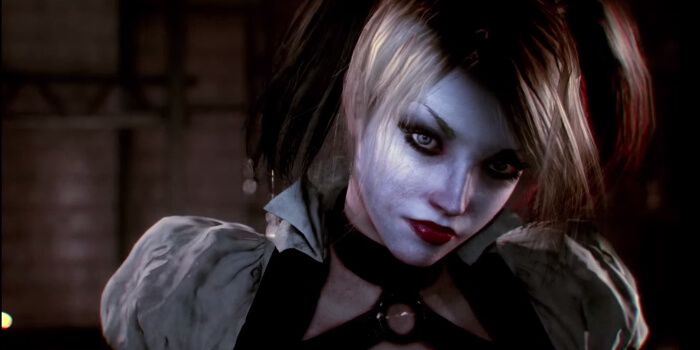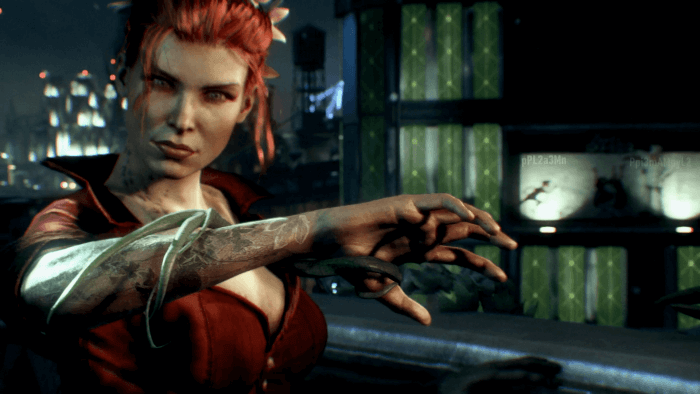After nearly a full year of delays, Batman: Arkham Knight is finally here. Gamers are able to hunt down new Riddler trophies, zoom around the streets in the Batmobile, or soar over skyscrapers in Gotham. Despite an enormous budget and plenty of pre-order cash flowing in, the game has launched with a few major problems. Although the main technical issue has been that the game is nearly unplayable on many PCs there are some narrative and character problems, as well.
There's no denying that Batman: Arkham Knight is an incredibly well-made game. The combat, exploration, and detective mechanics are all as tight as ever and the final installment is one of the best in the series. That said, the game seems to be ages behind in its representation of women.
We'll get to specific details after the spoiler warning here, but it's safe to say that the game includes a handful of female comic book (and cartoon) characters who are incredibly smart and strong in their source material and wastes no time reducing them to damsels in distress or glorified power-ups for the Caped Crusader. We won't dive too deep into the game's major plot twists (you can do that over at our spoiler discussion), but be warned that some spoilers are incoming...
Poison Ivy
Aside from a brief conversation with Oracle (we'll come back to her later), the first woman in Batman: Arkham Knight to get major screen time is Poison Ivy. The villain is a serious player in Batman's rogues gallery and has proven to be a worthy foe time and time again in Batman lore. Despite her credentials, Arkham Knight introduces the character as a victim. This is a role the game keeps her in throughout the story.
Ivy has a gun to her head when we meet her and is saved by Batman. Although it's believable that she might be taken down by Batman's main adversaries in the game, it seems like a waste of a strong, scary villain to have her sitting at the gunpoint of a goon who she should be able to easily overpower. We do get a brief display of her powers in this scene, but she is quickly put back in captivity without much of a fight at all.
This offense would be forgivable if the game didn't keep Ivy In this position of captivity throughout its entirety. Batman moves Ivy from one cell to another and keeps her there (hardly dressed, of course) until he needs to use her powers. She acts as a power-up for Batman later in the game, so we do get to see her powers eventually, but it's not on her own terms. She is removed from prison by the hero, just so he can control her and her powers. This becomes a trend with most of the powerful female characters in the game...
Catwoman
Much like Poison Ivy, Catwoman is also introduced as the damsel in distress. Catwoman is often portrayed as an equal of Batman in other media and in Fox's Gotham we even see a young version of the character mentor Bruce on fighting and troublemaking. That isn't so much the case in Arkham Knight.
Catwoman's wardrobe covers up a lot more than Ivy's, but Selina is basically bursting out of her costume while strapped to a chair waiting for Batman to save her. By this point, it becomes pretty clear that the creators of Arkham Knight have lost sight of the idea that the sexiness of these characters is derived from their power, not just their looks.
Batman and Catwoman work together to break the character free, but all of the glory is reserved for Batman, who plays the knight in shining armor once again. The player jumps back and forth between control of the two as they attempt to remove Catwoman's deadly choker, but the scene doesn't really give Catwoman a chance to shine at all.
Oracle
The worst offender of Arkham Knight's representation of women is definitely the treatment of Oracle. We'll avoid explicit spoilers (because they relate to the game's main surprise), but it's safe to say that players are asked to sit by and watch Batman's main ally in the game take a disturbing amount of abuse. The game clearly draws from The Killing Joke, a comic that was controversial at its release years ago, but also caused a stir more recently when an issue of Batgirl's alternate cover made reference to the story. Arkham Knight should have noticed from the recent alternate cover debacle that this isn't a story fans have any interest in revisiting.
The real problem with revisiting this controversial plot is that, much like in the original comic, the abuse towards Oracle exists entirely to drive the angst of the male characters. Players hear Oracle get viciously attacked and then spend the rest of the game watching Bruce, Gordon, Robin, and the rest of the male cast act out their vengeance for the violent act (sometimes utilizing the new dual play feature). This is an outdated plot device that is not only unoriginal, but also feels lazy. There are better ways to give drive to heroes and we would love to see Rocksteady explore new ideas instead of retreading these old ones.
Harley Quinn
To end on a positive note, this installment in the franchise definitely offers an upgrade to Harley Quinn. When the Joker's right-hand lady first appeared in Arkham Asylum, she was little more than eye candy. This time around Harley is as powerful as comic and cartoon fans would expect the iconic character to be. She marches around the city shouting orders at an army of goons and is in complete control. She's a villain for a major section of the game, and even if she doesn't get much time to shine in combat at least she isn't completely tossed aside. In fact, gamers can even take control of Harley Quinn in the pre-order DLC pack.
Closing Thoughts
The real disappointment with the representation of women in Arkham Knight is that the game actually has a great number of female characters to work with and clearly has no idea what to do with them. Just the four that we mentioned are enough to make the game offer more female representation than the average AAA title and if Rocksteady would have used them for anything more than damsels in distress, the company might have been taking a big step forward for big budget games.
After this year's E3, it's no secret that late 2015 and 2016 may signify a new era of the female protagonist. We hope that games like Tomb Raider and Horizon can learn from Arkham Knight's mistakes and put their female characters in more interesting and original situations.
What did you think of the representation and treatment of women in Arkham Knight? What would you like to have seen the creators do differently? Let us know in the comments.
Batman: Arkham Knight is now available for Xbox One, PlayStation 4, and PC.


